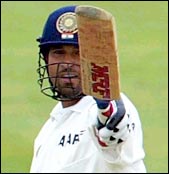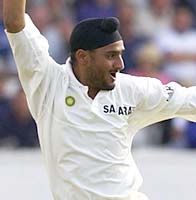Return to basics
Daniel Laidlaw
From the start, the third Test appeared somehow cast in a slightly different
mould. Conditions in the preceding two should have been reasonably
favourable to India imposing their preferred style of cricket; yet just the
opposite happened: It was England who batted with more initiative, bowled
with more purpose, and generally appeared to possess the plan and desire to
take charge of the series.
Even without knowing the conditions, the third Test at Headingley, on the
other hand, would have been expected to suit England clinching the contest.
With India having been played into a hole and acquiesced in digging part of
it themselves, the seam and bounce which prevailed should have been
conducive to England finishing them off.
Yet, ironically, it is in these circumstances that India mustered the
determination to finally assert itself on the series. There had been
glimpses, but they were mainly confined to batting in the second innings -
the belated spirit shown on day five of the first Test, and the effort of
Tendulkar, Dravid and Ganguly to save what the bowlers had all but lost in
the second. Both those innings, however, were rearguard; neither set the
tone.
 The third Test began differently. Two spinners and a makeshift opener in
part intimated the plan, which then evolved along the type of lines that
must be envisaged at team meetings. It was as if a decision had been made to
return to basics and adopt a traditional method, irrespective of conditions:
Bat first, watchfully compile an unassailable total over two days, then
unleash the spinners to wear down the opposition with the confidence of
those runs behind them. It is possibly the simplest and most time-honoured
way to win Tests, and certainly much more suited to India's strengths.
The third Test began differently. Two spinners and a makeshift opener in
part intimated the plan, which then evolved along the type of lines that
must be envisaged at team meetings. It was as if a decision had been made to
return to basics and adopt a traditional method, irrespective of conditions:
Bat first, watchfully compile an unassailable total over two days, then
unleash the spinners to wear down the opposition with the confidence of
those runs behind them. It is possibly the simplest and most time-honoured
way to win Tests, and certainly much more suited to India's strengths.
With a solidity and purpose that perhaps reflected the unified stance on
contracts in the dressing room, that is exactly what transpired. England,
theoretically stronger with Caddick and Tudor returning, thoroughly failed
to exert the pressure on India's batsmen that had seen them make inroads in
the previous two first innings.
What tests they did pose were answered by Dravid, who exhibited all his best
qualities. On the first day, both Bangar and Dravid appeared to feel the
weight of responsibility that had been placed on them by India's position,
and their demeanour reflected the occasion. Watchful and concentrated,
Dravid provided the innings with its necessary foundation, the well-known
temperament and discipline a feature. He appeared to accept the
responsibility of batting for as long as needed, eschewing expansive strokes
but increasing the tempo as the situation warranted.
Without an express bowler and with Flintoff apparently impeded by injury,
England failed to exploit the conditions. But it wasn't explained by lack of
resources. Hussain seemed to too readily concede his bowlers were not
capable of taking wickets by conventional means, as England were lamely
reduced to bowling short at Tendulkar from around the wicket. It was a
departure from the purpose with which they'd previously performed; too
tactical when the simplicity of an accurate good length would have sufficed.
India's reformed approach was only fully emphasised by Ganguly's
extraordinarily selfless batting late on day two. Accepting the offer of
poor light could potentially have meant the difference between drawing and
winning the series. One never knows. In the second Test, England cost
themselves time that would have been invaluable by being too negative in
this regard.
India could not lose the match by that stage so batting on was the only
appropriate decision to make. That in no way indicated a hitting spree would
result, but it is to Ganguly's credit that it did. He risked missing another
century by initiating the counter-attack but, Sunil Gavaskar's admonition
from the Sky commentary box notwithstanding, he set a commendable example.
The only criticism to make about the amazing assault in the gloom was why it
was left so late. If that is how Ganguly and Tendulkar are capable of
batting when it is dark, then one can only imagine what India might more
regularly achieve with just a little more inspiration under normal
conditions.
 If nothing else, the sensational display proved that batsmen can indeed
continue past the time umpires would typically allow play to stop, and that
a change of regulations is in order. The approach could not have contrasted
more with that of both sides at Trent Bridge.
If nothing else, the sensational display proved that batsmen can indeed
continue past the time umpires would typically allow play to stop, and that
a change of regulations is in order. The approach could not have contrasted
more with that of both sides at Trent Bridge.
The total thus accelerated, the match-winners were provided with the runs,
time and confidence to ply their craft at an optimum level. Anil Kumble
finally had an away surface on which he could extract his dangerous steep
bounce. Harbhajan Singh, with a phalanx of catchers around the bat, could
follow his own plans uncompromised by a need for containment or lack of
support from wayward seamers. Even Ajit Agarkar was able to maintain a
consistent line and length for a time.
With the spinners operating, England's batsmen appeared under a hitherto
absent pressure and, unsurprisingly, the entire attack benefited. One could
almost see the self-belief returning at the joyful rediscovery of the type
of cricket India are capable of playing. A little more of it, and the series
is wide open again.
More Columns
Mail Daniel Laidlaw